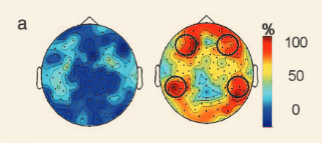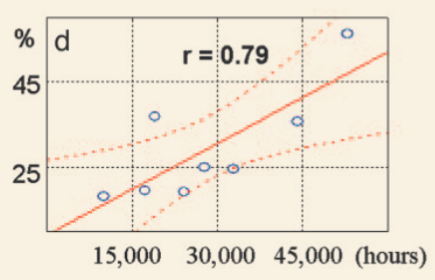Background Information
This study investigated the impact of long-term meditation practice on the brain, focusing on experienced Buddhist practitioners compared to novice volunteers. The researchers used electroencephalogram (
EEG
An electroencephalogram (EEG) is a recording of brain activity. During this painless test, small sensors are attached to the scalp to pick up the electrical signals produced by the brain.
More on Wikipedia
View in glossary
) recordings to measure brain activity in two groups: one consisting of long-term Buddhist meditators with thousands of hours of meditation experience, and another group of student volunteers with no prior meditation experience but who received a week of meditation training for the study.
The researchers found significant differences in the brain activity in the two groups, focusing specifically on
Gamma
Gamma brain waves are a type of brainwave pattern that oscillate at approximately 25 to 100 Hz. Gamma waves are associated with states of heightened perception, problem-solving, and consciousness. Gamma waves play a crucial role in cognitive functioning, including memory, and information processing, and are thought to integrate thoughts and information from different parts of the brain.
More on Wikipedia
View in glossary
-waves, which are fast brain waves associated with higher cognitive and emotional processes. The study found that the experienced meditators produced extremely high levels of gamma brain wave activity during meditation, which is suggestive that they have developed an enhanced capacity for concentration, emotional control, and a heightened state of awareness compared to people with less meditation experience.
What They Did
THe study included two groups of participants. The first group included eight Buddhist practitioners with 15 to 40 years of experience in meditation, amounting to between 10,000 to 50,000 hours of practice. The second group consisted of 10 healthy student volunteers who were meditation novices. Before the meditation sessions began, the researchers recorded a baseline EEG from each participant. This involved having the participants rest with both eyes open and closed in random order to measure their natural brain activity without meditation.
Each participant then engaged in meditation on the
Brahmavihārās
Brahma Vihara meditation, also known as the Four Immeasurables, involves cultivating four qualities: loving-kindness (metta), compassion (karuna), empathetic joy (mudita), and equanimity (upekkha). It aims to develop a state of unconditional love, compassion towards suffering, joy in the happiness of others, and a balanced mind in all situations.
More on Wikipedia
View in glossary
, focusing on generating a state of “unconditional loving-kindness and compassion.” This type of meditation does not focus on specific objects, memories, or images but aims to pervade the mind with benevolence and compassion. The novice group received instructions and practiced this meditation for an hour daily for a week before the EEG recordings.
EEG data were captured before, during, and after the meditation sessions, with particular attention to gamma-band oscillations, which are fast brain waves associated with higher cognitive and emotional processes. This figure shows measurements of gamma brain waves in a single meditator during a single meditation session.

One Big Result
Experienced meditators in the tradition of unbounded metta meditation can produce high levels of gamma brain wave activity during meditation, which suggests they have developed an enhanced capacity for concentration, emotional control, and a heightened state of awareness compared to people with less meditation experience.
We found robust gamma-band oscillation and long-distance phase-synchrony during the generation of the nonreferential compassion meditative state.
To put what this means into some context, gamma waves are associated with several aspects of cognition, perception and emotion, including:
- Enhanced Perception: Gamma waves are thought to be involved in the processing of sensory information, contributing to heightened awareness and perception of the environment.
- Consciousness: They have been linked to states of conscious awareness, integrating different streams of thought and sensory information into a cohesive experience of reality.
- Attention and Focus: High levels of gamma activity are associated with intense focus and concentration, helping the brain to process and react to information more effectively.
- Learning and Memory: Gamma waves play a crucial role in the encoding of memory and the learning process, facilitating the synaptic plasticity necessary for these functions.

Interestingly, the researchers found that the experienced meditators showed levels of Gamma waves that have only previously been reported under abnormal conditions, such as during epileptic seizures or in patients with brain tumors.
The high-amplitude gamma activity found in some of these practitioners are, to our knowledge, the highest reported in the literature in a nonpathological contex
This result is indicative that the conscious experience of meditators is foundationally different from that of non-meditators.
Miscellaneous Interesting Takeaways
Meditation Changes Your Brain at Rest
The paper also covered scans of the subject’s brains while they were not meditating, and here there was a second striking result.
In addition to the meditation-induced effects, we found a difference in the normative EEG spectral profile between the two populations during the resting state before meditation. It is not unexpected that such differences would be detected during a resting baseline, because the goal of meditation practice is to transform the baseline state and to diminish the distinction between formal meditation practice and everyday life
It appears clear that a long-term meditation practice changes the brain even when the meditator is not actively meditating such that the brain is more likely to be in a state of heightened awareness and emotional control. THe size of this effect was correlated stringly with the number of hours of meditation that the meditators had performed, with more meditation leading to stronger gamma waves at rest

Full-brain Coordination
Synchrony is the coordination of brain activity across different regions. Synchrony occurs when brain waves in widely different parts of the brain fire together. The researchers found that the experienced meditators showed a greater increase in synchrony patterns during meditation than the novice meditators.
The size of synchrony patterns increased more for the long-time practitioners than for the controls from neutral to meditation states. These data suggest that large-scale brain coordination increases during mental practice
Different Types of Meditation Are, Well, Different
This study used meditators who were bracticing boundless metta meditation. Most studies (for example, Hagerty et al, 2013, also summarized on this site) use mditation from concentration traditions.
The authors note that the results of this study are completely incompatible with the results of those other studies, which find primarily increases in alpha and theta brain waves.
These concentration techniques can be seen as a particular form of top-down control that may exhibit an important slow oscillatory component. First-person descriptions of objectless meditations, however, differ radically from those of concentration meditation. Objectless meditation does not directly attend to a specific object but rather cultivates a state of being
This particular result indicates that there are likely a large variety of altered states achievable through meditation, and that different techniques will have different effects on the brain.
More recent research by Maher et al. (2025) extends these findings by localizing increased gamma activity to specific brain regions including the amygdala and hippocampus during loving-kindness meditation, even in novice practitioners. In contrast to the high-amplitude gamma synchrony observed here during non-referential compassion, Hagerty et al. (2013) found that jhana meditation produces different patterns of neural activity, emphasizing increased activation in reward networks and decreased activity in self-referential processing areas.
Citation
Lutz, A., Greischar, L. L., Rawlings, N. B., Ricard, M., & Davidson, R. J. (2004). Long-term meditators self-induce high-amplitude gamma synchrony during mental practice. In Proceedings of the National Academy of Sciences (Vol. 101, Issue 46, pp. 16369–16373). Proceedings of the National Academy of Sciences. 10.1073/pnas.0407401101